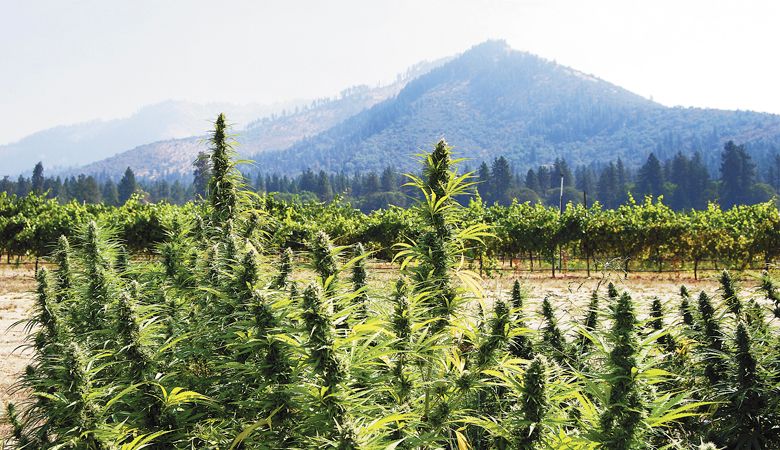Growing Pains
Cannabis operations lure pickers
Somehow, this year manages to keep outdoing itself in terms of sobering strangeness. Winemakers had enough to worry about when Oregon went into lockdown in mid-March and poor weather during bloom across large sections of major growing areas set the stage for significantly lower yields.
As the growing season progressed, COVID-19 did also, and not for the better. Meanwhile, colossal wildfires created so much smoke in August and beyond that other nations, separated by entire oceans, could see it. And this is to say nothing of the ongoing racial justice movement ignited by the murder of George Floyd.
So, when it came time to harvest in 2020, many winemakers were justifiably looking to catch a break. Instead, some had to forego a vintage due to unusually low yields or smoke damage. Others had more difficulty getting fruit simply off the vines, forced to compete with a substantial and largely unregulated cannabis and hemp sector. Growers like Michael Moore of Southern Oregon’s Quail Run Vineyards experienced something wholly new and bothersome.
“In 32 years of farming, we’ve never had a more difficult time finding not only pickers for harvest but temporary workers throughout the season,” Moore said. One crew, in particular, usually eleven strong, was reduced to only two people this year. The vineyard managed, but the picks themselves often lingered longer than Moore would have liked. As we all know, picking time is crucial and can essentially make or break a vintage.
Cannabis and hemp growers were busy trimming last year’s crop and preparing for harvest as grapes were ripening. The two agricultural industries found themselves competing for labor during the crucial early fall stretch.
“The issue is that you have crops based entirely on cash competing with crops that are legitimate,” he said. Moore adds that it’s not just weed growers but hemp growers as well, a group that’s riding particularly large wave right now thanks to the surging CBD market. Their high rates attract workers. Moore says that wages during the season ranged from $16 to $20 an hour in cash and went as high as $25 in cash during peak season.
“Imagine how it would be if you had two houses being built, one that had to pull permits, get inspections, pay workers comp, and state and federal payroll taxes, and next door, another house was being built where everything was done in cash,” Moore explained. It’s a dramatic analogy but a fitting one for those who have lost out to higher paying industries. Moore can’t help but wonder what outfits paying straight cash are up to. They’re dodging tax payments and essentially leaving no paper trail for applicable deductions. Some think some of these operations might be laundering money in some form or another.
On top of the mounting competition, Southern Oregon was dealt an extraordinarily awful fire season. Towns like Phoenix and Talent, the latter Quail Run calls home, were devastated by flames. Moore says five of his 18 full-time employees lost homes. While he tried to help them resettle he dealt with phone call after phone call about worried fruit buyers inquiring about smoke damage. In the end, Moore sold all his fruit, for which he is extremely grateful, but not without immense effort.
The perfect storm of negative factors forced Moore to harvest mechanically when necessary. While this technology continues to evolve, it’s still largely the source of much skepticism, especially in Oregon where smaller producers still make up the majority. Moore acknowledges that mechanical harvesting will almost surely continue out of necessity, despite what he says is about a 10% to 12% loss in fruit based on how the machines work.
Looking ahead, concern lingers. Moore and other winegrowers are worried they simply won’t be able to compete with cannabis rates if the system remains the same. It’s important to realize the relative youth of the cannabis realm, one Moore says is currently enjoying Wild West-like oversight. He argues that it is poorly regulated and not subject to the same scrutiny that is standard for farmers of wine grapes, hazelnuts, row crops or Christmas trees might. Perhaps heightened regulation is on its way. Perhaps not.
Either way, the competition aspect is likely not going away. If states like California are any indication, winegrowers will continue to be challenged by other well-paying, thriving industries, whether it’s cannabis or construction. The labor force has always followed the money and never is that more the case than amid a limping economy.
It’s possible that part of the draw to cannabis is not just the untaxed cash flow but relative safety. Many in this labor demographic are Latinx, a group that’s been targeted particularly hard by the current federal administration. ICE raids have become commonplace, whether to intimidate legal employees or deport undocumented ones in all kinds of work environments, from farms to factories. Perhaps there’s less risk of that kind of terrifying government interference in a realm like cannabis, where there’s less regulation.
Two sides can work together, of course, as they’re already doing in parts of California and elsewhere. There’s much nuance to the story, and it’s one that will continue to develop over the next several growing seasons. Wine has enjoyed quite the status over the last several decades, becoming America’s most popular alcoholic beverage. The terroir movement has placed a premium on place and with higher-end wines especially, which means more expensive land.
Given that context, it’s not entirely surprising that cannabis and hemp are among the few industries that can shake things up. They, too, are lucrative crops sold with plenty of markup and profit allowing them to compete with a product like premium Pinot Noir, for example. But if one industry is benefiting from lighter oversight than the other, there’s clearly a problem.
It’s a developing issue not reserved for just Southern Oregon. The two sides have competed along the West Coast, with some growers in the Willamette Valley recently voicing concern. A comprehensive solution has yet to be conceived, but like anything, the dilemma will benefit from increased awareness, conversation and hopefully some collaboration.













